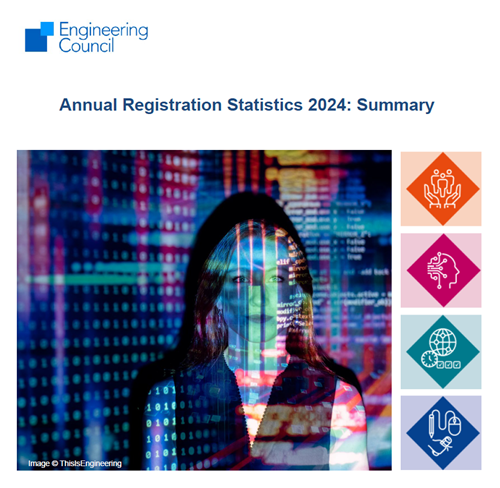Engineering Council


Professional Registration Statistics 2024
Professional registration is a vital tool for upholding trust and confidence in the engineering profession.
This summary presents a snapshot of our key database – the national Register of engineers and technicians who have been assessed against our Standards of professional competence and commitment.
Overview
At the end of 2024 there were 214,671 people on the Register, holding at least one final stage title.
- The total number of registrants has fallen by 1% from 2023, a decline of 3% over the past seven years.
- Approximately 80% of all registrants hold Chartered Engineer as their highest title. The remaining 20% are evenly distributed between those holding Incorporated Engineer and Engineering Technician titles, with a relatively small number holding the more recent and specialised ICT Technician title.
- The vast majority of registrants hold a single professional title, with 3.6% holding multiple titles. The most titles held by a single registrant is six.
- An additional 5,696 hold interim titles, pending completion of their professional review. These are treated separately for the purposes of this report.
While more than a third (35.1%) of registrants are aged over 60, the proportion of younger registrants is increasing year on year.
- The percentage share of each of the three younger age groups (16-29, 30-39 and 40-49) has increased slightly from 2023 to 2024, while the share of each of the three older age groups (50-59, 60-69 and 70+) has decreased.
The vast majority of registrants are male (91.7%) but the proportion of females is steadily increasing year-on-year.
- The proportion of females on the Register has increased from 5.9% in 2018 to 8.2% in 2024
The average age at which people join the Register is 34. The average age at which they leave is 59.
- Females tend to join 2-3 years earlier and leave 16-18 years earlier than males, spending less than half the time on the Register.
Retention
The retention rate in 2024 was 95.1%, showing that the vast majority of registrants in 2024 were also active the previous year.
- For the past seven years retention has remained steady between 94% and 96%.
- Retention has remained high across all the professional titles.
Joiners
The number of new registrants in 2024 was higher than both 2023 and 2022.
- There were 9,368 new registrants in 2024, an increase of 13.1% from 2023.
- More females were added to the Register in 2024 than any previous year.
- Approximately 1 in 6 people joined the Register as an Incorporated Engineer in 2024, up from 1 in 10 in previous years. More than half joined as Chartered Engineers.
- There were 1,142 people returning after a period of lapsed registration.
Leavers
More people left the Register in 2024 than joined, resulting in a net loss of 3,531 registrants.
- The average age for males leaving the Register is 60, with a peak age group of 60-64. This suggests many keep their registration until retirement.
- Females tend to leave the Register earlier, at an average age of 44. This is consistent with wider trends of females leaving the engineering workforce at this age
Titles
There were 222,785 titles recorded on the Register in 2024.
- This number is falling very slowly, following the same trajectory as the number of registrants, as would be expected.
- The number of Chartered Engineer (CEng) and Incorporated Engineer (IEng) titles have both fallen by 1% since 2023, with the other titles falling by 2%.
- The reduction in IEng titles is significantly less than previous years. In 2024, 1,530 people joined the Register with an IEng title, compared with 898 in 2023.
International
Consistent with previous years, 20% of titles were held outside the UK in 2024.
- The proportion of Chartered Engineer titles held by registrants living outside the UK is increasing very slightly year on year, by 2.4% over the past eight years.
- Of the titles held outside the UK, 57% are held in Asia, 15.5% in Oceania, 13.3% in Europe, 11.2% in Americas and 2.9% in Africa. This share has increased slightly in Asia and Europe and decreased slightly elsewhere.